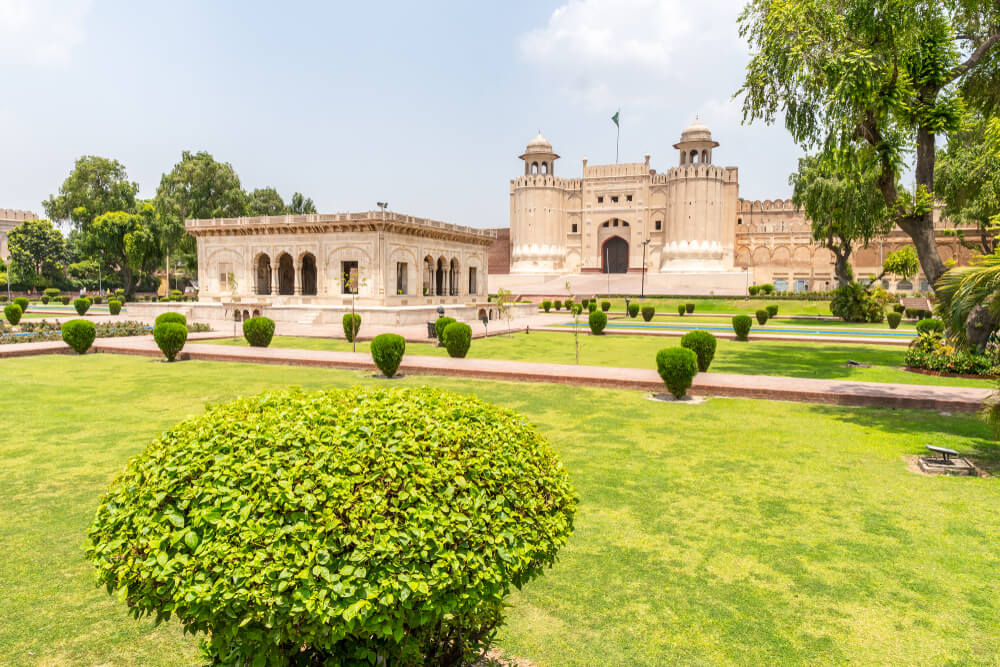Hazuri Bagh:
Hazuri Bagh (Urdu: حضوری باغ) is a garden in Lahore, Punjab, Pakistan, bounded by the Lahore Fort to the east, Badshahi Mosque to the west, the Samadhi of Ranjit Singh to the north, and the Roshnai Gate to the south. The garden was built during the reign of Maharaja Ranjit Singh, in the style of Mughal gardens. In the centre of the garden stands the Hazuri Bagh Baradari, built by the Maharaja in 1818 to celebrate his capture of the Koh-i-Noor diamond from Shuja Shah Durrani in 1813.[1][2][3][4] The Serai Alamgiri caravanserai formerly stood where Hazuri Bagh is now located.
History
Hazuri Bagh is at the centre of an ensemble of monuments including the Badshahi Mosque, Lahore Fort, Roshnai Gate, and the Samadhi of Ranjit Singh
The Hazuri Bagh garden was planned and built under the supervision of Faqir Azizuddin in the traditional Mughal style layout. After its completion, it is said, Ranjit Singh, at the suggestion of Jamadar Khushhal Singh, ordered that marble vandalized from various mausoleums of Lahore to construct a baradari (pavilion) here. This task was given to Khalifa Nooruddin. Elegant carved marble pillars support the baradari's delicate cusped arches. The central area, where Ranjit Singh held court, has a mirrored ceiling. Both the garden and the baradari, originally a 45-foot, three-storey square with a basement approached by fifteen steps, suffered extensive damage during the Sikh wars and was only reclaimed and laid out according to the original plan during the British period. On 19 July 1932, the top story collapsed and was never rebuilt or restored.[1][4] The tomb of Muhammad Iqbal, completed in 1951, as well as of Sikandar Hayat Khan, the last Premier of the Punjab, lies across from the garden outside of the Badshahi Mosque.[4]
Every Sunday afternoon, people gather in the garden to hear story tellers recite traditional Punjabi Qisse, such as Heer Ranjha and Sassi Punnun, and other Punjabi Sufi poetry.[3]
Why Hazuri Bagh famous:
The Architecture of Hazuri Bagh:
You will see that this whole garden resembles the Mughal-style layout. The central pavilion, also called Baradari, is the heart of this garden you will love the most. Ranjit Singh ordered the construction of this Baradari with white marble. Still, he settled on stripping marble from other Mughal buildings due to a lack of funds for new marble.
Some of the marble you will see covering the pavilion was stripped from the Tomb of Nur Jahan, Zeb-un-Nisa, and Asif Khan. The whole top was from the Tomb of Jahangir. The original Baradari was a double story, but in 1932, the upper story was demolished due to a storm. What you see now is just a single-story pavilion.
This Baradari is covered with lush green and a well-maintained garden on four sides. There are also many small fountains in the garden for you to witness.
There are 16 ornamented pillars inside this Baradari. It is a square structure with stairs on two sides. There is also a basement with chambers, but it is not accessible. The ceiling is covered with mirrors and colorful marble pieces.
Attractions at Hazuri Bagh Lahore
There are many attractions in Hazuri Bagh for you. You can enjoy the lush gardens and fountains while resting.
Once you have visited Badshahi Mosque and Lahore Fort, you can sit in this beautiful garden and enjoy your evening here. There is also a Baradari Present in the center of Hazuri Bagh. It is a beautiful square pavilion made of white marble.

Surrounding the famous garden, you will see the main entrance of Lahore Fort_the Alamgir gate, Badshahi Mosque, Tomb of Allama Muhammad Iqbal, Samadhi of Ranjit Singh, and Roshnai Gate. You can enjoy all these attractive places while visiting Hazuri Bagh.
Beautiful Fountains with Shaded Lights
Beautiful fountains cover the whole garden and shaded lights beside them add a wonderful accent to this garden. You will see the wonders it creates at night time especially. The sprinkling water looks like falling pearls.









0 Comments